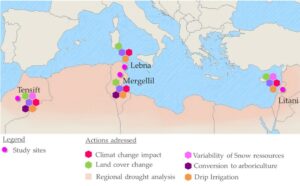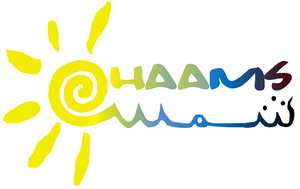WP5 « Trajectories, impacts and mitigation » (Y. Fakir and A. Al Bitar)
Lead : UCAM/FSS and IRD/CESBIO
This work package aim is to produce and analyze water resources trajectories (2020-2040), as well as to evaluate adaptation solutions to mitigate water scarcity. It is based on former WP outputs (WP 2, 3, 4, 6), as well as climate change scenarios (IPCC RCP 4.5 and 8.5 from the MEDCORDEX ensemble). The action will use the modelling tools and datasets from WP2 and WP4 as well as public policies from WP3. It will be based on the integrated modelling tools already developed over the study sites (SAMIR-WEAP-MODFLOW -Le Page et al., 2012 from WP6- SWAT and SAFRAN-ISBA-MODCOU models implemented in Lebna and Tensift, respectively). The activities of this WP are designed to be the result of intensive exchanges with regional and national stakeholders and decision-makers. The figure below shows the main questions that are addressed on each pilot sites.

Proposed tasks
5.1 Building the future scenarios
Input: MedCordex ensemble-WP3-WP4 / Output: Task 5.3
This task develops a multi-disciplinary vision to generate a plausible evolution of the continuous interactions between human and environmental components of the water system based on the analysis of the past decades. This action will benefit from the involvement of the stakeholders and decision makers in the different sites. A comprehensive dataset will be built to run the future scenarios composed of : (1) the climate run from reference IPCC simulations and their associated land cover evolution if no mitigation or major policies are implemented; (2) the future policies “translated” in terms of practices (change in the water use efficiency, earlier seeding dates …). A particular focus will be put on the extension/intensification of arboriculture and on the implementation of the green plan in Morocco and the Litany plan in Lebanon.
5.2 Climatic and Anthropogenic changes
Input: Task 5.2, WP4 / Output: Task 5.4
This action consists in producing the future projections by running the modelling tools forced by the built scenarios. The run will cover the 2020-2040 years to produce potential trajectories. We will analyse the drivers of the change by differentiating climate and anthropogenic and quantify the impact of a climate breakdown (drought) on the system. Readily available integrated modeling platform will be used to make an accurate estimation of the hydrological cycle at long timescales based on the water use patterns. Quantitative results will be qualitatively confronted to water quality degradation trends observed to imagine future challenges for modelling. A special focus will be put on the response of the snowpack using a distributed energy balance model that was already forced and validated using automatic weather station data in the High Atlas and Mount Lebanon. This model will be used to perform an analysis of the ablation processes (partition melt/sublimation, water that does not contribute to streamflow) in response to the projected temperature changes.
5.3 Drought analysis from past to future
Input: Task 5.2-WP2-WP4 / Output: WP6
At the Mediterranean south basin scale, an analysis based on long time series of remote sensing observations (SM, ETR, drought indicators and groundwater dynamic assessed at large scale from the GRACE data) and integrated modelling platform outputs will be carried out to characterize the meteorological, agronomical and hydrological droughts.
5.4 Impact of mitigation and adaptation solutions
Input: Task 5.2-5.3-5.4-WP3-WP4 / Output: Stakeholders – Media sources
The objective of this task is to explore and to evaluate the impact of new ways of sustainable water management based on the existing integrated modelling tools. We will define what-if scenarios in close collaboration with local managers and stakeholders in order to contribute to the definition of public policies. We propose to explore four fostered solution against water scarcity: deficit irrigation, conversion to drip irrigation, artificial groundwater recharge through augmented streambeds, optimization of the sowing date of cereals in the context of temperature rise.
Deliverables:
- D5.1: Report on drought analysis M24
- D5.2: Report on Building Future scenarios M30
- D5.3: Report on Impact of climate and anthropogenic changes on water resources M33
- D5.4: Report on Impact of Mitigation and adaptation for Mediterranean water resources M33
